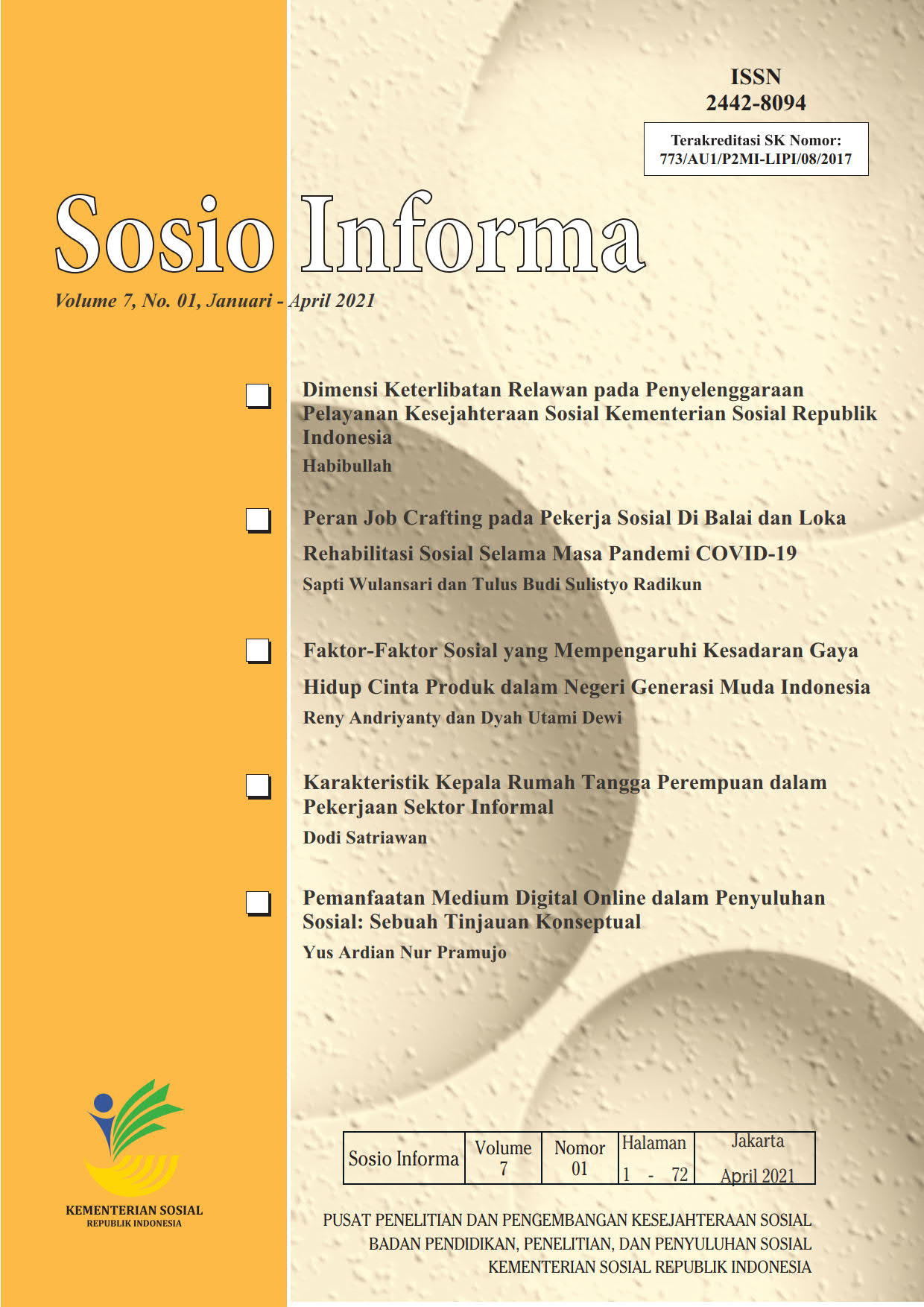PEMANFAATAN MEDIUM DIGITAL ONLINE DALAM PENYULUHAN SOSIAL: SEBUAH TINJAUAN KONSEPTUAL
DOI:
https://doi.org/10.33007/inf.v7i1.2650Keywords:
Penyuluhan sosial, penyuluh sosial, komunikasi, medium digital onlineAbstract
Internet memberikan ruang bagi Penyuluh Sosial melakukan kegiatan penyuluhan tidak hanya dengan tatap muka, tetapi juga memanfaatkan medium digital online. Penyuluh Sosial melalui teknik tersebut dapat berperan sebagai komunikator yang mengirimkan pesan kepada para pemangku kepentingan sebagai komunikan. Dengan prosesnya tetap mewujudkan penyuluhan sosial yang baik dan memberikan dampak positif kepada para pemangku kepentingan. Penyuluhan sosial menggunakan medium digital online turut serta dalam pembangunan kesejahteraan sosial. Kajian ini adalah tinjauan konseptual yang dibangun dari teori-teori komunikasi yang relevan dengan penyuluhan sosial dalam memanfaatkan medium digital online. Pembahasan terdiri dari teori kultivasi, teori agenda setting, teori priming, dan teori elaborasi kemungkinan. Konseptual aplikasi pemanfaatan medium digital online yang relevan untuk penyuluhan sosial dibahas seperti aktivisme gerakan sosial yang memanfaatkan petisi online dan media sosial; endorsement online tentang selebriti yang memiliki pengaruh untuk menawarkan barang atau jasa; dan buzzer tentang pemanfaatan media sosial untuk mendengungkan hasil karya seseorang. Kajian ini menyimpulkan bahwa Penyuluh Sosial perlu membekali diri dengan teori-teori komunikasi yang relevan dengan penyuluhan sosial. Melalui cara itu, Penyuluh Sosial dapat menjangkau kelompok masyarakat lebih banyak, dan sekaligus memperluas wawasan dalam mengkampanyekan program dan kegiatan peningkatan kesejahteraan sosial.
References
Abeza, G., O’reilly, N., Séguin, B., & Nzindukiyimana, O. (2017). The world’s highest-paid athletes, product endorsement, and twitter. Sport, Business and Management: An International Journal, 7(3), 332–355. https://doi.org/10.1108/SBM-08-2016-0040
BPS. (2021). Statistik Indonesia 2021.
Cornelissen, J. (2014). Corporate communication: a guide to theory & practice (4th ed.). Sage Publications.
Croteau, D., Hoynes, W., & Milan, S. (2011). Media/Society: Industries, Images, and Audiences (4th ed.). Sage Publications, Inc.
Dainton, M., & Zelley, E. D. (2019). Applying Communication Theory for Professional Life (4th ed.). s.
Fiske, J. (1990). Introduction To Communication Studies (2nd ed.). Routledge.
Griffin, E. (2019). A First Look at Communication Theory (10th ed.). McGraw-Hill Education.
Hanna, R., Rohm, A., & Crittenden, V. L. (2011). We’re all connected: The power of the social media ecosystem. Business Horizons, 54(3), 265–273. https://doi.org/10.1016/j.bushor.2011.01.007
Liang, X., Su, L. Y. F., Yeo, S. K., Scheufele, D. A., Brossard, D., Xenos, M., Nealey, P., & Corley, E. A. (2014). Building buzz: (Scientists) communicating science in new media environments. Journalism and Mass Communication Quarterly, 91(4), 772–791. https://doi.org/10.1177/1077699014550092
Lin, L. F., Li, Y. M., & Wu, W. H. (2015). A social endorsing mechanism for target advertisement diffusion. Information and Management, 52(8), 982–997. https://doi.org/10.1016/j.im.2015.07.004
Littlejohn, S. W., Foss, K. A., & Oetzel, J. G. (2017). Theories of human commmunication (11th ed.). Waveland Press, Inc.
McMullan, J. (2017). A new understanding of ‘New Media’: Online platforms as digital mediums. Convergence, 26(2), 287–301. https://doi.org/10.1177/1354856517738159
Morgan, M. (2009). Cultivation Analysis and Media Effects. In R. L. Nabi & M. B. Oliver (Eds.), The SAGE Handbook of Media Processes and Effects (pp. 69–81).
Ni, A. Y. (2013). Comparing the Effectiveness of Classroom and Online Learning: Teaching Research Methods. Journal of Public Affairs Education, 19(2), 199–215. https://doi.org/10.1080/15236803.2013.12001730
O’Keefe, D. J. (2009). Theories of Persuasion. In R. L. Nabi & M. B. Oliver (Eds.), The SAGE Handbook of Media Processes and Effects (pp. 269–282). Sage Publications, Inc.
Perbersama Mensos dan Kepala BKN. (2008). Peraturan Bersama Menteri Sosial dan Kepala Badan Kepegawaian Negara Nomor 41/HUK-PPS/2008 Nomor 13 Tahun 2008 Tentang Petunjuk Pelaksanaan Jabatan Fungsional Penyuluh Sosial dan Angka Kreditnya.
Permensos RI No 16. (2017). Peraturan Menteri Sosial RI Nomor 16 tahun 2017 tentang Standar Nasional Sumber Daya Manusia Penyelenggara Kesejahteraan Sosial.
Permensos RI No 5. (2019). Peraturan Menteri Sosial Republik Indonesia Nomor 5 Tahun 2019 tentang Pengelolaan Data Terpadu Kesejahteraan Sosial.
Permensos RI No 8. (2012). Permensos Nomor Republik Indonesia Nomor 08 Tahun 2012 tentang Pedoman Pendataan dan Pengelolaan Data.
Roskos-Ewoldsen, D. R., & Roskos-Ewoldsen, B. (2009). Current Research In Media Priming. In R. L. Nabi & M. B. Oliver (Eds.), The SAGE Handbook of Media Processes and Effects (pp. 177–192). Sage Publications, Inc.
Shah, D. V., McLeod, D. M., Gotlieb, M. R., & Lee, N. J. (2009). Framing and Agenda Setting. In R. L. Nabi & M. B. Oliver (Eds.), The SAGE handbook of media processes and effects (Vol. 23, Issue 1, pp. 83–98). Sage Publications, Inc.
UU No 11. (2009). Undang Undang Republik Indonesia Nomor 11 Tahun 2009 tentang Kesejahteraan Sosial.
UU No 13. (2011). Undang Undang Republik Indonesia Nomor 13 Tahun 2011 tentang Penanganan Fakir Miskin.
Veil, S. R., Reno, J., Freihaut, R., & Oldham, J. (2014). Online activists vs. Kraft foods: A case of social media hijacking. Public Relations Review, 41(1), 103–108. https://doi.org/10.1016/j.pubrev.2014.11.017
Zeren, S. G. (2015). Face-to-face and online counseling: Client problems and satisfaction. Egitim ve Bilim, 40(182), 127–141. https://doi.org/10.15390/EB.2015.4696
Downloads
Published
How to Cite
Issue
Section
Citation Check
License
Copyright (c) 2021 Yus Ardian Nur Pramujo

This work is licensed under a Creative Commons Attribution-NonCommercial-ShareAlike 4.0 International License.
Authors who publish with this journal agree to the following terms:
- Authors retain copyright and grant the journal right of first publication with the work simultaneously licensed under a Creative Commons Attribution-NonCommercial-ShareAlike 4.0 International License that allows others to share the work with an acknowledgement of the work's authorship and initial publication in this journal.
- Authors are able to enter into separate, additional contractual arrangements for the non-exclusive distribution of the journal's published version of the work (e.g., post it to an institutional repository or publish it in a book), with an acknowledgement of its initial publication in this journal.
- Authors are permitted and encouraged to post their work online (e.g., in institutional repositories or on their website) prior to and during the submission process, as it can lead to productive exchanges, as well as earlier and greater citation of published work (See The Effect of Open Access).









